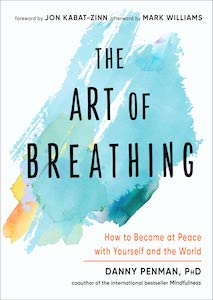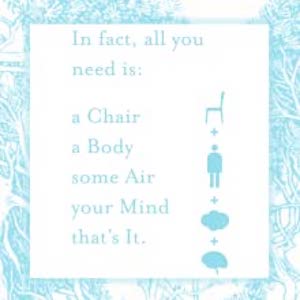
The Art of Breathing: How to Become at Peace with Yourself and the World, by Danny Penman
Hampton Roads Publishing, 1642970425, 128 pages, May 2022
Breathing may just seem like the simplest thing in the world – something that doesn’t even cross our minds on a daily basis, it just happens to us. Naturally, The Art of Breathing: How to Become at Peace with Yourself and the World by Danny Penman PhD has much more to say on the subject. If breathing is really an art, it must be an ability which we can develop and deepen to reach a far greater depth than the usual automatic bodily process we’re so familiar with. Penman’s depth of experience and expertise as a meditation teacher and award-winning author certainly delivers on that promise.
Going hand-in-hand with developing breathwork is the practice of mindfulness, which has become such a prevalent subject in recent times. As these topics have gradually diffused into western culture, and as more and more books, courses, and retreats emerge every year, how does an individual book stand out amid the crowd? Penman’s answer is to match the form to the content, which is certainly the most striking aspect of this little book.
The Art of Breathing doesn’t seek to simply impart information and techniques, like so many other books on these subjects do. Instead, the design of the books is a delightful journey through visual space as well as the realm of ideas. You almost can’t find a page without some sort of illustration, alternative layout, or background image that draws in your senses and evokes the presence of the natural world while you learn how to harness the power of your breath.

Some texts on meditation and mindfulness can be a little dry, like an instruction manual that has great results promised at the end, but Penman’s book takes an entirely different approach. As the title suggests, mindfulness practices are not meant to be solely therapeutic but also aesthetic. The quality of your experience is at least as important as the less-stressed, calm, and present state of mind you wish to gain. The immersion in imagery, which often involves plants, animals, and other scenes from Nature, helps to ground the reader in the world rather than removing awareness to the abstract mental realm.
As many practitioners of mindfulness, meditation, yoga, etc. would tell you, deliberately striving to achieve a specific result is more likely to be a hindrance than a help.
“The aim of mindfulness is not to intentionally clear the mind of thoughts. It is to understand how the mind works. To see how it unwittingly ties itself into knots to create anxiety, stress, unhappiness, and exhaustion.”1
Instead, Penman writes that mindfulness provides you with a place where one’s thoughts and emotions may be observed like the rise and fall of the waves, and in those spaces between lies a realm of expanding insight.
One of the specific features of this book that stands out is the design of the meditations and other exercises presented throughout the chapters. You might be familiar with meditations in other books that are paragraphs of text instructing you what to do. But if you aren’t a long-practicing meditator, those kinds of instructions can be difficult to hold in mind – especially while you’re supposed to be paying less attention to what the mind is saying. Not an ideal method for this sort of practice, unless you happen to have a picture-perfect memory. This is another place where Penman’s dedication to an aesthetic quality of presentation manages to shine forth.

In addition to offering audio versions of the meditation exercises on his website, Penman solves the problem of “too much text” by using flow charts set against the background of a great tree, full of tangled branches. It’s so easy to imagine a nest of birds hiding just out of sight while your eyes move over these pages, reinforcing the strong connection with the natural world that the author is encouraging us to remember. While engaging in these practices, it is a simple matter to glance at the next bubble in the flowchart to see the next step of the exercise. I found this incredibly helpful at keeping my attention focused on the exercise, moving from one step to the next without having to search for the place I’d left off.
The artistic style and layout isn’t the only aesthetic feature of this book either. Mindfulness practices can sometimes get stuck in the meditation-phase, where it seems like the only way that this quality of experience develops is by just focusing on the breath. But there’s so much more than breathing in Penman’s work.
For instance, you’ll find a Fruit Meditation, which takes mindfulness out of the breathwork realm for a moment and into the full range of the senses. Through deliberate exploration of a piece of fruit in all its sensory aspects, the exercise heightens your attention to all the little details packed into the simple activity of eating. Experiencing the manifold presence of a piece of fruit is an awakening to the quality of our sensations that our usual habits and attitudes might be ignoring.

This emphasis helps us move beyond the mindfulness found in meditation exercises and brings it out into the everyday world – a bridge that many books find difficult to cross. Penman is also unafraid to challenge common practices and conceptions about mindfulness and meditation. He argues, for example, that many people – especially beginners – would find cross-legged, lotus position meditation difficult and distracting.
Instead of trying to force yourself to sit in the “proper” position, where the discomfort of the body may hinder your ability to relax into a mindful state, Penman suggests that all you need is a Chair, a Body, some Air, your Mind, and that’s it! Although developing different positions and postures may be great in the long-run, your practice shouldn’t be held back on that account.
Overall, The Art of Breathing receives a big, two-thumbs-up recommendation. Although much of the content about breathwork, mindfulness, and meditation can be obtained from many other sources, Penman’s book stands out in its artistic presentation. This gives the work a sense of wholeness and integrity, which helps immerse the reader more deeply and immediately in the quality of awareness that is the subject of the book. And while it’s a short book – you can easily read the whole thing in an hour – its wisdom and exercises are so easy to return to that you’ll want to find it a prominent space on your shelf.

Zak has two master’s degrees in philosophy, from Brandeis University and University of California Santa Barbara. He is currently the lead editor for Dungeons in a Box, and he spends much of his time in the realm of fantasy crafting new plots and ensuring the adventure is in mechanical balance. When he’s not DMing, he also enjoys hiking, studying eastern philosophy, and playing board games.
